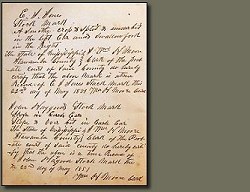
One of the most read poems during the Christmas season is Clement Clarke Moore’s A Visit From St. Nicholas, originally published during the 1820’s. This timeless classic has been read by generations spanning three centuries and today, 184 years after its first publication, it is still being enjoyed by young and old alike.
Clement Clarke Moore, author of A Visit From St. Nicholas, was born July 15, 1779 and died July 10, 1863. He was the son of Benjamin (president of Columbia College) and Charity Clarke Moore. Clement Clarke Moore graduated from Columbia during 1798 and on November 20, 1813 he married Catharine Elizabeth Taylor. He was made professor of Biblical learning in the General Theological Seminary in New York during 1821 and held that post until 1850. A Visit From St. Nicholas first appeared anonymously in the Troy, New York Sentinel on December 23, 1823, and was reprinted frequently thereafter.
Upon Moore’s death in 1863 at his summer residence in Newport, Rhode Island, his funeral was held in Trinity Church in Newport, where he had owned a pew. His body was interred in the cemetery of St. Luke's Episcopal Church on Hudson Street in New York City and on November 29, 1899, his body was re-interred in Trinity Churchyard Cemetery in New York.
The following version of A Visit From St. Nicholas was transcribed from American Monthly Magazine, New Series, Vol. III, New York, Scatcherd and Adams, 1837, page 99
‘Twas the night before Christmas, when all through the house
Not a creature was stirring, not even a mouse;
The stockings were hung by the chimney with care,
In hopes that St. Nicholas soon would be there;
The children were nestled all snug in their beds,
While visions of sugar-plums danced through their heads;
And mamma in her ‘kerchief, and I in my cap,
Had just settled our brains for a long winter’s nap –
When out on the lawn there arose such a clatter,
I sprang from the bed to see what was the matter:
Away to the window I flew like a flash,
Tore open the shutters and threw up the sash.
The moon, on the breast of the new-fallen snow,
Gave the luster of mid-day to objects below.
When, what to my wondering eyes should appear,
But a miniature sleigh and eight tiny rein-deer,
With a little old driver, so lively and quick,
I knew in a moment it must be St. Nick,
More rapid than eagles his coursers they came,
And he whistled, and shouted, and called them by name;
“Now, Dasher! Now, Dancer! Now, Prancer! Now, Vixen!
On! Coment, on! Cupid, on! Donder and Blixen –
To the top of the porch! To the top of the wall!
Now, dash away, dash away, dash away all!” –
As leaves that before the wild hurricane fly,
When they meet with an obstacle, mount to the sky,
So up to the house-top the coursers they flew,
With the sleigh full of toys – and St. Nicholas too.
And then in a twinkling I heard on the roof
The prancing and pawing of each little hoof.
As I drew in my head, and was turning around,
Down the chimney St. Nicholas came with a bound.
He was dressed all in fur, from his head to his foot,
And his clothes were all tarnish’d with ashes and soot;
A bundle of toys he had flung on his back,
And he look’s like a pedlar just opening his pack.
His eyes – how they twinkled! His dimples, how merry!
His cheeks were like roses, his nose like a cherry;
His droll little mouth was drawn up like a bow,
And the beard on his chin was as white as the snow.
The stump of his pipe he held tight in his teeth,
And the smoke, it encircled his head like a wreath.
He had a broad face, and a little round belly
That shook, when he laugh’d, like a bowl full of jelly.
He was chubby and plump; a right jolly old elf;
And I laugh’d when I saw him, in spite of myself.
A wink of his eye and a twist of his head,
Soon gave me to know I had nothing to dread.
He spoke not a word, but went straight to his work,
And fill’d all the stockings; then turned with a jirk,
And laying his finder aside of his nose,
And giving a nod, up the chimney he rose.
He sprang to his sleigh, to his team gave a whistle,
And away they all flew like the down of a thistle;
But I heard him exclaim, ere he drove out of sight,
“Happy Christmas to all, and to all a good night!”
Illustration: "Merry Old Santa Claus," by Thomas Nast, Harper's Weekly, January 1, 1881, pp.8-9
 One of the old secluded cemeteries of Itawamba County is known as the Bean Cemetery located in southwestern Itawamba County just west of English Creek about three miles west of Enon Church and north of the Carolina community. It has been said that this old cemetery is the site of the original Enon Church, one of Itawamba County’s first organized churches, established during the 1830’s.
One of the old secluded cemeteries of Itawamba County is known as the Bean Cemetery located in southwestern Itawamba County just west of English Creek about three miles west of Enon Church and north of the Carolina community. It has been said that this old cemetery is the site of the original Enon Church, one of Itawamba County’s first organized churches, established during the 1830’s. 











































